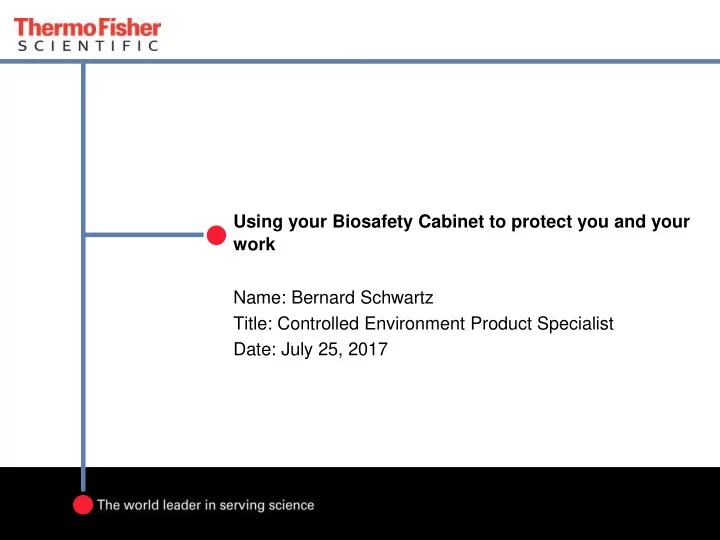

Using your Biosafety Cabinet to protect you and your work Name: Bernard Schwartz Title: Controlled Environment Product Specialist Date: July 25, 2017
Agenda • 1. A2 BSC • 2. HEPA Filter • 3. Aseptic Technique – General • 4. Organize workflow • 5. Before Starting • 6. Starting Work • 7. Working Tips • 8. Universal Precautions • 9. General Precautions • 10. Waste • 11. Spills • 12. Questions 2
Class II, Type A2 BSC • Class II, Type A2 BSC Airflow Diagram 3
HEPA Filter Typical HEPA Filter Efficiency Typical HEPA Filter Efficiency HEPA Filter expressed as percent penetration expressed as percent penetration Efficiency 0.000001% 0.000001% Percent Penetration as a percentage of upstream Percent Penetration as a percentage of upstream 0.000010% 0.000010% 0.000100% 0.000100% 0.001000% 0.001000% 0.010000% 0.010000% Virus Virus Bacteria Bacteria 0.100000% 0.100000% 0.01 0.01 0.10 0.10 1.00 1.00 Particle size in micrometers Particle size in micrometers 4
Aseptic Technique This facility manufactures products for clinical use These products must meet a number of requirements, one of which is that they are sterile In order to produce sterile components it is necessary to follow aseptic technique 5
Aseptic Technique Use of aseptic technique protects the product and the operator from exposure to infectious agents and contaminants The technique is a way of working that provides this protection The following slides provide basic information on aseptic technique 6
Aseptic Technique The idea behind aseptic technique is to PREVENT contamination It is not possible to “clean up” an already contaminated product by using aseptic technique In order to maintain sterility , it is necessary to start with a sterile product & handle it in an aseptic manner 7
Organize your work How to organize your supplies and work in the biosafety cabinet 8
Organize Workflow • From the US CDC/NIH “Primary Containment for Biohazards: Selection, Installation and Use of Biological Safety Cabinets” 3 rd Edition Dirty Clean (for right handed user) 9
Tx Tech 10
Caution with waste containers 11
Tx Tech 12
Is this on? 13
Before Starting Collect all of the reagents and materials that you will need onto a workspace close to the biological safety cabinet Make sure that you have a biohazard trash container, sharps container (if appropriate) and waste trap available – we recommend that waste traps be located on the floor OUTSIDE the BSC Make sure that you have disinfectant spray bottles containing 70% ethanol available 14
Before Starting Make sure that you are wearing the required personal protective equipment 1. Lab coat – Replace between products 2. Gloves 3. Eye Protection if necessary 4. Sleeve Covers - (when working with more than one product) 15
Before Starting Use alcohol to clean gloves before using the BSC !!!!!!! Minor Clean - Wipe down the working surface in the BSC with 70% ethanol and leave to dry Disinfect any equipment e.g. racks, before placing them into the BSC 16
Use of Alcohol 17
Starting Work When you start working, be sure that you work well inside the BSC and not directly above the front air vents Wrong !! Keep your nose and mouth away from the window opening 18
Starting work 19
Working Tips Tighten the caps on culture flasks before moving them to the BSC. Wipe down culture flasks with spray disinfectant before bringing them into the BSC. Decontaminate your gloves using alcohol frequently during the culture procedure Be careful not to touch the necks of culture flasks when removing the caps. Be careful not to touch the inside of the cap Place the cap either face up, or face down on an alcohol wipe. 20
Working Tips 21
Finishing your Work 22
UV 23
Working Tips Avoid extreme temperature changes A culture that becomes cloudy rapidly after incubating is probably contaminated Cultures that contain white or gray threads, or cotton wool-like floating particles usually are contaminated with fungus or mold Fungus and mold is difficult to cure effectively All contaminated cultures should be sterility tested to identify the contaminating organism 24
Universal Precautions All cell products should be regarded as potentially infectious Follow Universal Precautions when working with these products 25
General Precautions If you feel that you may have touched a sterile item – discard it and use a new one Clean up any spills immediately after decontaminating with disinfectant 26
Waste Discard old culture flasks into the biohazard trash after tightening the caps Disposable tips used with a Pipetman should be discarded into the waste container. DO NOT overfill waste containers 27
How to handle a spill in the biosafety cabinet 1. Neutralize. 2. Disinfect with Clorox Healthcare Bleach Germicidal Cleaner 3. Wipe everything removed with 70% ethanol. 4. Capture spill in appropriate container via spill valve. 5. Wipe down spill tray 6. Wipe down work surface 7. Run UV decon 28
Thermo Scientific Provides Tools You Can Use! • At Thermo, we are committed to providing the best customer experience before and after the sale • Expertise and history continue to drive innovation • Visit our website, www.thermoscientific.com/co2 to find: • Information about new and existing features • Interesting articles building on new discoveries • Helpful Application Notes • Informative Smart Notes • And more! • Have a question? Contact us! 29
Thank you for your attention! Name: Bernard Schwartz Title: Controlled Environment Product Specialist Email: bernard.schwartz@thermofisher.com Phone: 615/714-2436
Recommend
More recommend